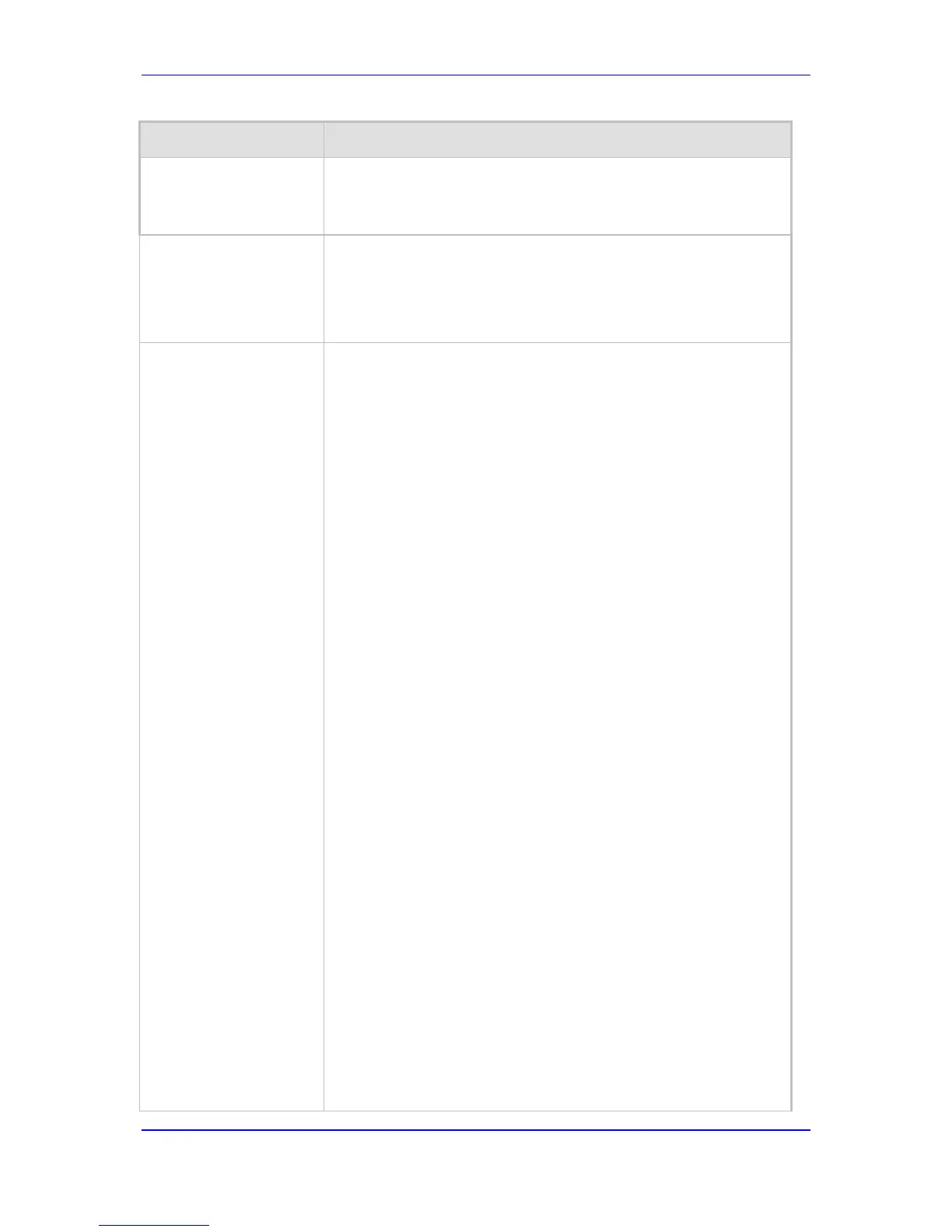Version 6.6 863 Mediant 800 MSBR
User's Manual 66. Configuration Parameters Reference
If the device receives a Request-URI that includes a 'target' and
'cause' parameter, the 'target' is mapped to the Redirect phone
number and the 'cause' is mapped to the Redirect number reason.
[WaitForBusyTime]
Defines the time (in msec) that the device waits to detect busy and/or
reorder tones. This feature is used for semi-supervised PBX call
transfers (i.e., the LineTransferMode parameter is set to 2).
The valid value range is 0 to 20000 (i.e., 20 sec). The default is 2000
(i.e., 2 sec).
Web/EMS: Line Transfer
Mode
CLI: line-transfer-mode
[LineTransferMode]
Defines the call transfer method used by the device. This parameter is
applicable to FXO call transfer as well as E1/T1 CAS call transfer if
the TrunkTransferMode_x parameter is set to 3 (CAS Normal) or 1
(CAS NFA).
[0] None = (Default) IP.
[1] Blind = PBX blind transfer:
Analog (FXO): After receiving a SIP
IP side, the device (FXO) sends a hook-flash to the PBX, dials
the digits (that are received in the Refer-To header), and then
immediately releases the line (i.e., on-hook). The PBX
performs the transfer internally.
E1/T1 CAS: When a SIP REFER message is received, the
device performs a blind transfer, by performing a CAS wink,
waiting a user-defined time (configured by the
WaitForDialTime parameter), dialing the Refer-To number,
and then releasing the call. The PBX performs the transfer
internally.
[2] Semi Supervised = PBX semi-supervised transfer:
Analog (FXO): After receiving a SIP REFER message from the
IP side, the device sends a hook-flash to the PBX, and then
dials the digits (that are received in the Refer-To header). If no
busy or reorder tones are detected (within the user-defined
interval set by the WaitForBusyTime parameter), the device
completes the call transfer by releasing the line. If these tones
are detected, the transfer is cancelled, the device sends a SIP
NOTIFY message with a failure reason in the NOTIFY body
(such as 486 if busy tone detected), and generates an
additional hook-flash toward the FXO line to restore
connection to the original call.
E1/T1 CAS: The device performs a CAS wink, waits a user-
defined time (configured by the WaitForDialTime parameter),
and then dials the Refer-To number. If during the user-defined
interval set by the WaitForBusyTime parameter, no busy or
reorder tones are detected, the device completes the call
transfer by releasing the line. If during this interval, the device
detects these tones, the transfer operation is cancelled, the
device sends a SIP NOTIFY message with a failure reason
(e.g., 486 if a busy tone is detected), and then generates an
additional wink toward the CAS line to restore connection with
the original call.
[3] Supervised = PBX Supervised transfer:
Analog (FXO): After receiving a SIP REFER message from the
IP side, the device sends a hook-flash to the PBX, and then
dials the digits (that are received in the Refer-To header). The

